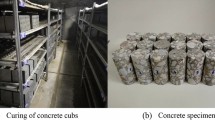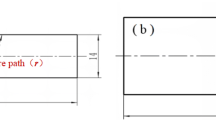Abstract
This article reports a statistical analysis of acoustic emission (AE) avalanches in cementitious composites generated during unconfined uniaxial compression and flexural loading. The analysis emphasises on the probability distribution of absolute AE energies of the individual AE events and on the time correlations (aftershock rate for Omori’s law and waiting time between successive AE events for Universal Scaling Law). Under compression, the G-R exponent (\(\epsilon\)) remained constant at 1.15, 1.21, 1.21 and 1.32 for specimens having steel volume fraction (Vf) 0%, 0.8%, 1.6% and 2% respectively, for at least three decades (represents the powers of ten, i.e., \(10^{1}\) is one decade, \(10^{2}\) is two decades and so on) under uniaxial compression. A decrease in \(\epsilon\) was observed as the damage in the material progressed for compressive fracture and Mode I fracture process. Distribution of other AE avalanche characteristics like inter-event time and waiting time (\(\delta )\) distribution show almost similar characteristics for varying Vf.


















Similar content being viewed by others
Availability of data and material
Not applicable.
References
Aggelis DG (2011) Classification of cracking mode in concrete by acoustic emission parameters. Mech Res Com 38(3):153–157
Bak P, Christensen K, Danon L, Scanlon T (2003) Unified Scaling Law for Earthquakes. Phys Rev Lett 88:178501
Baró J, Corral A, Illa X, Planes A, Salje EKH, Schranz W, Soto-Parra DE, Vives E (2013) Statistical similarity between the compression of a porous material and earthquakes. Phys Rev Lett 110:088702
Baró J, Martín-Olalla J, Romero F, Gallardo M, Salje E, Vives E, Planes A (2014) Avalanche correlations in the martensitic transition of a Cu-Zn-Al shape memory alloy: analysis of acoustic emission and calorimetry. J Phys Condens Matter 26:125401
Baró J, Planes A, Salje EKH, Vives E (2016) Fracking and labquakes. Philos Mag 96:686
Baró J, Shyu P, Pang S, Jasiuk IM, Vives E, Salje EKH, Planes A (2016) Avalanche criticality during compression of porcine cortical bone of different ages. Phys Rev E 93:053001
Baró J, Dahmen KA, Davidsen J, Planes A, Castillo PO, Nataf GF, Salje EKH, Vives E (2018) Experimental evidence of accelerated seismic release without critical failure in acoustic emissions of compressed nanoporous materials. Phys Rev Lett 120:245501
Bauke H (2007) Parameter estimation for power-law distributions by maximum likelihood methods. Eur Phys J B 58:167–173
Carpinteri A, Lacidogna G, Puzzi S (2009) From criticality to final collapse: evolution of the b-value from 1.5 to 1.0. Chaos Solitons Fractals 41:843–853
Carpinteri A, Lacidogna G, Corrado M, Di Battista E (2016) Cracking and crackling in concrete-like materials: a dynamic energy balance. Eng Fract Mech 155:130–144
Castillo-Villa PO, Baró J, Planes A, Salje EKH, Sellappan E, Kriven WM, Vives E (2013) Crackling noise during failure of alumina under compression: the effect of porosity. J Phys: Condens Matt 25:292202
Drossel B, Schwabl F (1992) Self-organized critical forest-fire model. Phys Rev Letters 69(11):1629
Chen Y, Ding X, Fang D et al (2019) Acoustic emission from porous collapse and moving dislocations in granular Mg-Ho alloys under compression and tension. Sci Rep 9(1):1–12
Choi S, Shah SP, Thienel C (1996) Strain softening of concrete in compression under different end constraints. Mag Conc Res 48(175):103–115
Clauset A, Rohilla-Shalizi C, Newman MEJ (2009) Power-law distributions in empirical data. SIAM Rev 51:661–703
Colombo IS, Main IG, Forde M (2003) Assessing damage of reinforced concrete beam using b -value analysis of acoustic emission signals. J Mat Civil Eng 15:280–286
Corral A (2004) Universal local versus unified global scaling laws in the statistics of seismicity. Physica A 340:590–597
EN-14651 (2007) Test method for metallic fibre concrete—measuring the flexural tensile strength (Limit of Proportionality (LOP), Residual), Brussels, Belgium
Gutenberg B, Richter CF (1944) Frequency of earthquakes in California. Bull Seismol Soc Am 34(4):185–188
Helmstetter A (2003) Is earthquake triggering driven by small earthquakes? Phys Rev Lett 91:058501
Hoffmann H, Payton DW (2018) Optimisation by self-organised criticality. Sci Rep 8:2358
IS: 519 (2004) Method of Tests for Strength of Concrete, Bureau of Indian Standards, New Delhi, India
Jiang X, Liu H, Main IG, Salje EKH (2017) Predicting mining collapse: superjerks and the appearance of record-breaking events in coal as collapse precursors. Phys Rev E 96:023004
Katsnelson MI, Vanchurin V, Westerhout T (2021). Self-organized criticality in neural networks. arXiv preprint https://arxiv.org/abs/arXiv:2107.03402.
Lacidogna G, Accornero F, Carpinteri A (2019) Influence of snap-back instabilities on Acoustic Emission damage monitoring. Eng Fract Mech 210:3–12
Lavrov AV, Shkuratnik VL (2005) Deformation and fracture induced acoustic emission in rocks. Acoust Phys 51:S2–S11
Mäkinen T, Miksic A, Ovaska M, Alava MJ (2015) Avalanches in Wood Compression. Phys Rev Lett 115:055501
Nataf GF, Castillo-Villa PO, Baró J, Illa X, Vives E, Planes A, Salje EKH (2014) Avalanches in compressed porous SiO2-based materials. Phys Rev E 90:2405
Nataf GF, Castillo-Villa PO, Sellappan P, Kriven WM, Vives E, Planes A, Salje EKH (2014) Predicting failure: acoustic emission of berlinite under compression. J Phys Condens Matter 26:275401
Navas-Portella V, Corral A, Vives E (2016) Avalanches and force drops in displacement-driven compression of porous glasses. Phys Rev E 94:033005
Navas-Portella V, Serra I, Corral A, Vives E (2018) Increasing power-law range in avalanche amplitude and energy distributions. Phys Rev E 97:022134
Newman MEJ (2005) Power laws, Pareto distributions and Zipf’s law. Contemp Phys 46(5):323–351
Ribeiro HV, Costa LS, Alves LGA, Santoro PA, Picoli S, Lenzi EK, Mendes RS (2015) Analogies between the cracking noise of ethanol-dampened charcoal and earthquakes. Phys Rev Lett 115:025503
Salje EKH, Lamprosi GI, Soto-Parra DE, Baró J, Planes A, Vives E (2013) Noise of collapsing minerals: predictability of the compressional failure in goethite mines. Am Mineral 98:609
Salje EKH, Planes A, Vives E (2017) Analysis of crackling noise using the maximum-likelihood method: Power-law mixing and exponential damping. Phys Rev E 96 (042122)
Sethna JP, Dahmen KA, Myers CR (2001) Crackling noise. Nature 410:242–250
Soto-Parra D, Zhang X, Cao S, Vives E, Salje EKH, Planes A (2015) Avalanches in compressed Ti-Ni shape-memory porous alloys: An acoustic emission study. Phys Rev E 91:060401
Soto-Parra D, Vives E, Botello-Zubiate ME, Matutes-Aquino JA, Planes A (2018) Acoustic emission avalanches during compression of granular manganites. Appl Phys Lett 112:251906
Utsu T, Ogata Y, Matsu’ura RS (1995) The centenary of the omori formula for a decay law of aftershock activity. J Phys Earth 43(1):1–33
Vives E, Ortín J, Mañosa L, Ràfols I, Pérez-Magrané I, Planes A (1994) Distributions of avalanches in martensitic transformations. Phys Rev Lett 72:1694
Wang L, Jiang X, He X, Chu J, Xiao Y, Liu H, Salje EKH (2021) Crackling noise and biocementation. Eng Frac Mech 247:
Xu Y, Borrego AG, Planes A, Ding X, Vines E (2019) Criticality in failure under compression: Acoustic emission study of coal and charcoal with different microstructures. Phys Rev E 99:033001
Zapperi S, Vespignani A, Stanley HE (1997) Plasticity and avalanche behavior in microfracturing phenomena. Nature 388:658–660
Zhao YP (1998) On the similarity methods in fracture mechanics. Forsch Ingenieurwes 64(10):257
Funding
No funding was received to conduct this study.
Author information
Authors and Affiliations
Contributions
IS: investigation, formal analysis, data curation, software. RVS: conceptualization, methodology, writing—original draft, writing—review and editing, supervision, resources, project administration.
Corresponding author
Ethics declarations
Conflict of interest
The authors have no competing interest.
Additional information
Publisher's Note
Springer Nature remains neutral with regard to jurisdictional claims in published maps and institutional affiliations.
Appendix A: Relation between seismic \(b\)-value and \(\epsilon\)
Appendix A: Relation between seismic \(b\)-value and \(\epsilon\)

Appendix B: Implementation of Omori’s law
By analysing multiple aftershocks, the relation between average aftershock rate (\(r_{AS}\)) (i.e., number of aftershocks per unit time) as a function of the time difference from the instance of mainshock \(\left( {\Delta t = t - t_{MS} } \right)\) can be studied (Utsu et al. 1995),
where K is a time-independent constant, p is the Omori’s exponent, c is a small shift used to avoid a divergence at Δt = 0. The shift (c) is due to the undercounting of aftershock (overlapped with the mainshock) very close to the MS.
1.1 B.1. Implementation of the Productivity law
The \(r_{AS} \) would be constant \(\left( {p = 0} \right)\) if the earthquakes were Poissonian in Eq. (B.1). However, p has a value close to \(1.0\) for earthquakes. In Eq. (B.1), K determines the total number of aftershocks. K depends on the energy released during the mainshock (EMS). A power-law function gives the relationship (Productivity law) between K and EMS (Chen et al. 2019; Helmstetter 2003),
where \(K_{0}\) is a constant, and \(\alpha\) is an exponent. A scaling plot (in log–log scale) can be drawn, using Eq. (B.3), by taking a combination of Eq. (B.1) and Eq. (B.2), if exponents \(\alpha\) and \(p\) are universal, and by plotting \( E_{MS}^{{ - \frac{2\alpha }{3}}} r_{AS} \) versus (\(\Delta t = t - t_{MS} ).\)
Rights and permissions
About this article
Cite this article
Saha, I., Vidya Sagar, R. Statistical analysis of acoustic emission avalanches generated during the compressive fracture process, and Mode I fracture process in cementitious composites. Int J Fract 234, 273–295 (2022). https://doi.org/10.1007/s10704-022-00618-2
Received:
Accepted:
Published:
Issue Date:
DOI: https://doi.org/10.1007/s10704-022-00618-2




